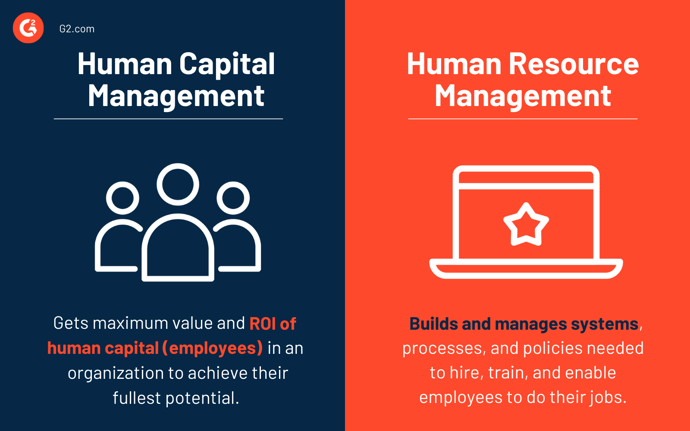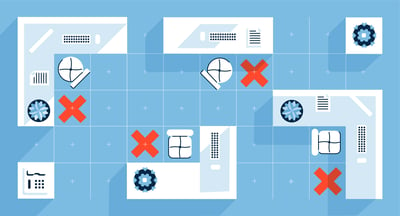March 29, 2021
 by Mara Calvello / March 29, 2021
by Mara Calvello / March 29, 2021

Your organization relies on a lot of tools and assets to hit its goals.
While you need certain hardware and software to succeed, at the end of the day, it comes down to the people who make up your organization. Do they feel fulfilled? Do they have everything they need? Are they being bottlenecked in any way?
To get these answers, you’ll need to have effective human capital management processes in place.
Human capital management (HCM) consists of the practices that go into human resource management that are centered around the employee. Businesses use these practices to attract top candidates and develop employees to their fullest potential so the organization can achieve success.
Essentially, HCM is completely centered around one thing: the employee. Which includes hiring, onboarding, developing, and optimizing each of them across all departments. How do you accomplish such a task? Let’s break it down.
It’s not uncommon for people to hear the term human capital management and think it’s synonymous for human resources management (HRM). While they are closely related, the two aren’t the same.
With human capital management, the goal is to get the most ROI (return on investment) of the human capitals (employees) within the organization. To put it simply, HCM is all about optimizing and investing in your employees to their fullest potential.
With human resources management, the goal is to build and manage systems, processes, and policies that are required to hire, train, retain, and enable your team of employees to do their jobs.
Something to keep in mind as you distinguish between the two is that HCM not only includes various HR tasks but also work practices and people management skills that will enhance the performance of an organization. Human capital will always extend well beyond the standard HR functionalities to also include people strategy.

Now that you have a better understanding of the ins and outs of human capital management, let's go over all of the varying components of strategic practices and administrative processes that it encompasses.
First and foremost, the foundation of human capital management embodies a wide range of common HR functions. There are many core HR software solutions on the market that make it easier for the human resources department to do some of their daily tasks.
For example, some HR functions that overlap into human capital management include:
Depending on the right software solution you choose, you’ll be able to more effectively standardize and process payroll, compensation packages, and benefits plans. Using an ERP system payroll is streamlined because all employee information is centralized in one easy-to-read dashboard, where data regarding paid time off, personal employee details, and more, are stored.
Another crucial part of human capital management is efforts that go into attracting and hiring talent to help your organization achieve success. HCM tools provide the HR department with the resources it needs to amp up the recruitment process while also making it comprehensive and hassle-free for the candidate.
HR professionals should also keep in mind that PEO services exist as an alternative and popular method of hiring. Not only does human capital management speed up hiring, but it also allows your organization to establish an extensive talent pool that you can dip your toe into (pun intended) when roles become open at your company.
If you’re looking to manage human capital the right way, it requires effectively and efficiently handling the onboarding of new employees. Not only will it introduce them to the company culture, but also the requirements of the job and what is expected of them at your organization.
The work of human capital management doesn’t stop once an employee is fully ramped and onboarded. Once that part is done, it’s time to think about how you will provide adequate training to help employees perform to their best ability. It’s all about creating an environment that encourages growth and employee development, achieving a strong employee lifecycle, while wanting employees across all departments to gain new skills, deliver exceptional results, and grow their careers.
It’s also an important part of human capital management to collect data as you work with employees. This means, insights from performance reviews, turnover rate, employee retention, and employee satisfaction. From there, these metrics can be applied to adjust strategies and processes within the organization to improve the overall work environment.
There are many benefits to incorporating an HCM system into your company's strategy.
As mentioned, optimizing an HCM strategy will make it possible for your organization to attract and retain talent during your talent acquisition efforts. Your recruiters and HR leaders are bound to notice an increased hiring speed and the quality of the candidates, while the candidates you end up sourcing have a better chance of already obtaining the skills your company needs.
Another key benefit is that you’ll find that your organization has optimized workforce management. Compensation is easier to maintain, labor and scheduling are easier to manage, and expenses for various projects can be streamlined more effectively.
When done right, human capital management can also boost employee satisfaction. When employees across varying departments see that the organization is dedicated to their happiness and growth, they’ll feel like their workplace truly cares about their wellbeing.
Finally, when your HR team takes the time to perfect human capital management strategies, you’ll see improved organizational communication and culture. With free-flowing information surrounding changes internally, and stronger relationships forged across teams, everybody wins.
of HR leaders cite employee retention and turnover as their top workforce management challenge, followed by recruitment and corporate culture management.
Source: SHRM
Stuck in a rut with your human capital management strategy? Here are some ways HR leaders can give it a boost.
We touched on it briefly above, but to make the most of your HCM strategy, it’s important that, when considering talent management, your company doesn’t centralize all of its energy on hiring new talent and then putting this talent on the backburner once onboarded.
Yes, the candidate experience is important. But human capital management is more than that. If you want high employee engagement and employee retention, you need to keep your team happy in the short and long term. HR professionals should consider sending out surveys, asking for feedback, and scheduling quick meetings where you’re simply checking in.
As you go about managing your employees, remember that they’re not just cogs in your organization’s machine. Because of this, it’ll go a long way if you take a more personal approach to the day-to-day tasks that go into human capital management.
Consider their unique personalities, goals, and preferences as you tailor your management style. Understand what makes them “tick,” how to get them motivated, and the most effective communication style when speaking to each employee.
As an example, some employees may need frequent check-ins, while others can be left to their own devices. While some may prefer to communicate electronically via email or Slack, some may require face-to-face conversations to understand a concept.
There’s no one-size-fits-all approach to HCM, just like no two employees are the same. When you take this into consideration, the overall employee experience throughout your organization is bound to improve.
HCM technology has come a long way, and there are an abundance of options for your organization to choose from.
While we’ve already explained how core HR software can streamline various processes within HCM, solutions like compensation management software
also play a big role in helping HR leaders manage pay structures and benefits more effectively. Those tools aren’t the only options for human capital management software available. In conjunction with core HR tools, your organization has other options available.
For instance, there are human resource management suites that can be utilized to manage all human resource information within an integrated, modular system.
There’s also workforce management software, which is great for planning, managing, and tracking employee work, including labor requirements, employee schedules, and paid time off. These tools also typically utilize an employee self-service portal, where employees across departments can log in and check to make sure all of their personal details are accurate and up to date.
Performance management software can help managers and HR leaders establish employee performance standards and evaluate an individual employee’s job performance. These resources makes human capital management easier for everyone involved.
No matter the size of your organization or the industry it falls in, processes, strategies, and regulations are likely to change. When they do, it’s crucial for the team to communicate these changes with the team as they occur.
Change can be scary and stressful for everyone involved. Especially for human capital management, HR leaders must communicate early, often, and with as much detail as possible. Having open lines of communication can help make employees feel more at ease, especially when they know that questions are welcomed and encouraged.
If your organization is experiencing something like budget cuts or layoffs, communication should be framed in a constructive way while also remaining informative as the team answers employee concerns.
of employees would stay longer at an organization that listens to and addresses their concerns.
Source: Ultimate Software
At the end of the day, human capital management is centered around ensuring your organization gets the biggest bang for its buck regarding its capital – the employees. When you work toward prioritizing the development of the people who work toward enhancing the success of your organization, it’s time and money well spent.
Now that you know the ins and outs of human capital management, take a deep dive into how a human resources information system (HRIS) can boost your HR department even further.
Mara Calvello is a Content and Communications Manager at G2. She received her Bachelor of Arts degree from Elmhurst College (now Elmhurst University). Mara writes content highlighting G2 newsroom events and customer marketing case studies, while also focusing on social media and communications for G2. She previously wrote content to support our G2 Tea newsletter, as well as categories on artificial intelligence, natural language understanding (NLU), AI code generation, synthetic data, and more. In her spare time, she's out exploring with her rescue dog Zeke or enjoying a good book.
Day in and day out, the leaders within your human resources department have a lot on their...
 by Mara Calvello
by Mara Calvello
It’s common for employees to think the human resources team is only called on when something...
 by Mara Calvello
by Mara Calvello
Let’s face it, even the most perfect employee is going to miss work at some point.
 by Mara Calvello
by Mara Calvello
Day in and day out, the leaders within your human resources department have a lot on their...
 by Mara Calvello
by Mara Calvello
It’s common for employees to think the human resources team is only called on when something...
 by Mara Calvello
by Mara Calvello


